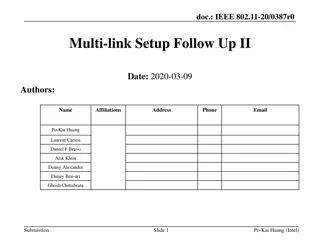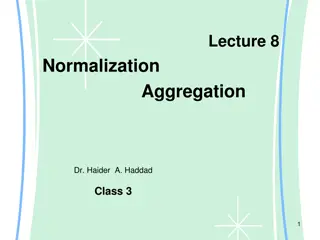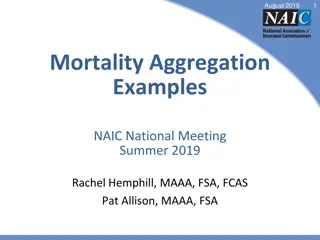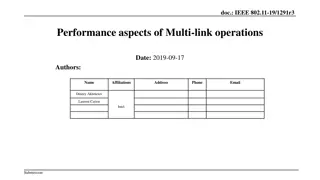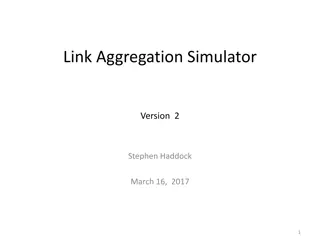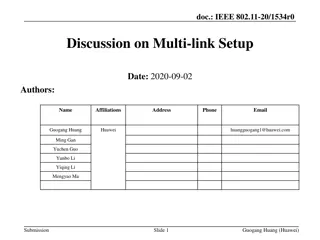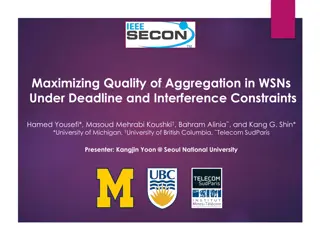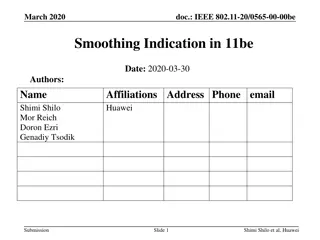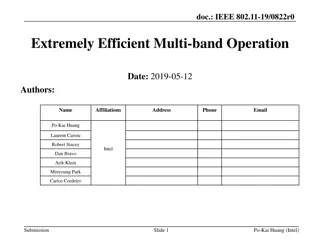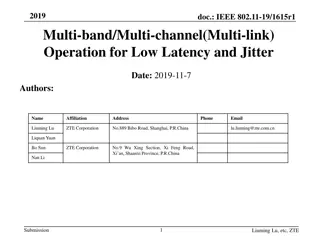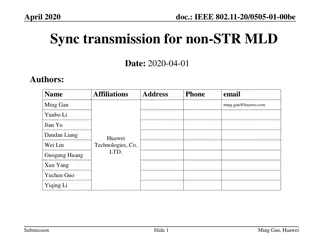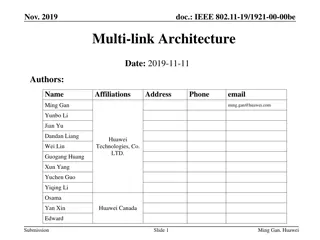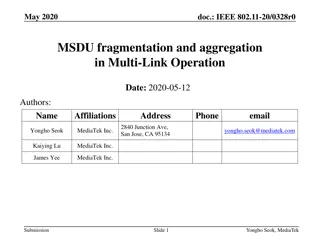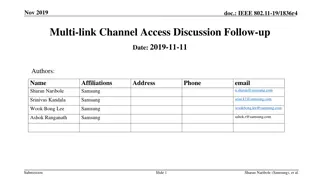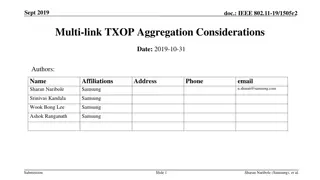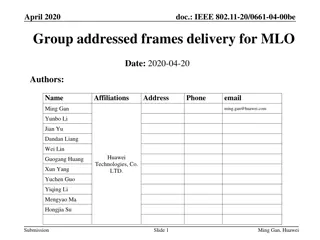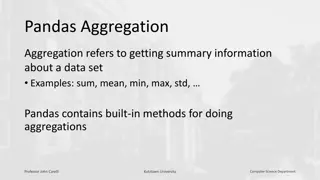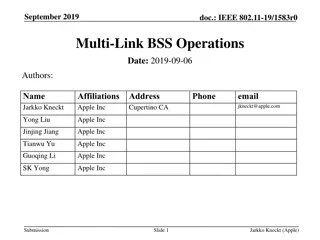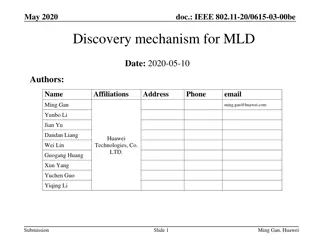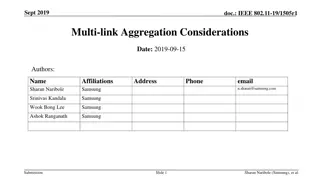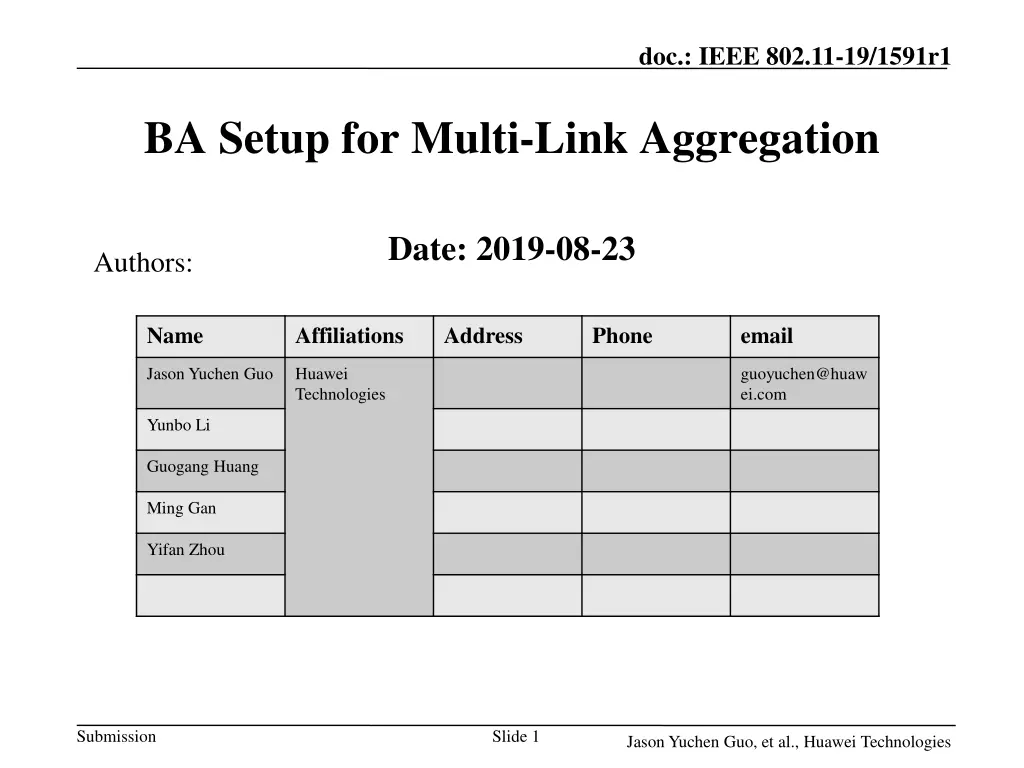
Multi-Link Aggregation Protocol
Explore the IEEE 802.11-19/1591r1 document outlining the setup for multi-link aggregation in wireless networking. The proposal suggests enhancements to the Block Acknowledgment (BA) setup process to facilitate improved throughput and reduced latency in multi-link transmission scenarios. Discover the innovative approach to BA setup for multi-link aggregation and its implications for enhancing wireless network performance and efficiency.
Download Presentation

Please find below an Image/Link to download the presentation.
The content on the website is provided AS IS for your information and personal use only. It may not be sold, licensed, or shared on other websites without obtaining consent from the author. If you encounter any issues during the download, it is possible that the publisher has removed the file from their server.
You are allowed to download the files provided on this website for personal or commercial use, subject to the condition that they are used lawfully. All files are the property of their respective owners.
The content on the website is provided AS IS for your information and personal use only. It may not be sold, licensed, or shared on other websites without obtaining consent from the author.
E N D
Presentation Transcript
doc.: IEEE 802.11-19/1591r1 BA Setup for Multi-Link Aggregation Date: 2019-08-23 Authors: Name Affiliations Address Phone email Jason Yuchen Guo Huawei Technologies guoyuchen@huaw ei.com Yunbo Li Guogang Huang Ming Gan Yifan Zhou Submission Slide 1 Jason Yuchen Guo, et al., Huawei Technologies
doc.: IEEE 802.11-19/1591r1 Introduction There have been many discussions on transmitting frames of the same TID across multiple links. [1] proposes to have a common BA session across all STAs within the MLO entity [2] proposes to define a TID-to-Link mapping, which allows a single TID to be mapped to one or more links. The frames belonging to the single TID are sent on the mapped link(s) [3] mentions dynamic band switch, which allows the frames for single TID to be transmitted in any band, and BA negotiation in one band apply to all bands It is also called multi-link aggregation (MLA), which is critical to improve the peak throughput, and to reduce latency for a particular application [3-4]. The BA setup protocol has been defined in the baseline spec, which should be done before the aggregated data transmission. However, it only allows frames of a particular TID to be transmitted on a single link. In this contribution, we propose a simple BA setup scheme for multi-link transmission based on the current the BA setup procedure. Submission Slide 2 Jason Yuchen Guo, et al., Huawei Technologies
doc.: IEEE 802.11-19/1591r1 Recap BA setup The BA setup procedure between an originator and a recipient in the Spec: It is an ADDBA request and ADDBA response frame exchange The ADDBA request and response frames carry the following information: ADDBA response ADDBA request Submission Slide 3 Jason Yuchen Guo, et al., Huawei Technologies
doc.: IEEE 802.11-19/1591r1 Recap BA setup However, in the current standard, the BA agreement can only be established on a single link If the multi-band element is not carried in the ADDBA request/response frames, the BA agreement is established on the transmitting link (the link that the ADDBA request/response frames are transmitted) If the multi-band element is carried in the ADDBA request/response frames, the BA agreement is established on the link indicated by the multi-band element Submission Slide 4 Jason Yuchen Guo, et al., Huawei Technologies
doc.: IEEE 802.11-19/1591r1 BA setup for multi-link aggregation In order to setup a BA agreement for multi-link transmission, we propose to carry multiple multi-band elements in the ADDBA request/response frames Order Information Order Information 1 Category 1 Category 2 Block ACK Action 2 Block ACK Action 3 Dialog Token 3 Dialog Token 4 Status Code 4 Block Ack Parameter Set 5 Block Ack Parameter Set 5 Block Ack Timeout Value 6 Block Ack Timeout Value 6 Block Ack Starting Sequence Control 7 GCR Group Address element (optional) 7 GCR Group Address element (optional) 8 Multi-band (optional) 8 Multi-band (optional) 9 Multi-band (optional) 9 Multi-band (optional) 10 TCLAS (optional) 10 TCLAS (optional) 11 ADDBA Extension (optional) 11 ADDBA Extension (optional) 12 Originator Preferred MCS (optional) ADDBA response ADDBA request Submission Slide 5 Jason Yuchen Guo, et al., Huawei Technologies
doc.: IEEE 802.11-19/1591r1 BA setup for multi-link aggregation The RA/TA of the ADDBA request/response frames shall be set to the MLO entity address of the originator and the recipient. When carried in the ADDBA request frame, the multiple multi-band elements indicate the links that the originator intends to operate on When multiple multi-band elements are carried in the ADDBA response frame with the value of the Status Code field set to SUCCESS, then a BA agreement has been established for multi-link aggregation across the indicated links The multi-band elements in the ADDBA response frame is a subset of the multi-band elements in the ADDBA request frame Once the BA agreement for MLA is established, the frames of the same TID indicated in the Block Ack Parameter Set can be transmitted on the multiple links, and the same sequence number space is shared for the frames. The recipient can send a single BA to acknowledge the data frames on all links, or send a BA for each link Link 1 SN=1 SN=2 SN=3 SN=4 BA SN=5 SN=6 SN=7 SN=8 Link 2 BA Submission Slide 6 Jason Yuchen Guo, et al., Huawei Technologies
doc.: IEEE 802.11-19/1591r1 Conclusion We propose a simple BA setup scheme for multi-link transmission based on the current the BA setup procedure Multiple multi-band element can be put in the ADDBA request and response frames to setup a BA agreement for multi-link aggregation Submission Slide 7 Jason Yuchen Guo, et al., Huawei Technologies
doc.: IEEE 802.11-19/1591r1 Straw Poll Do you support reusing ADDBA request and ADDBA response frames to setup a BA agreement for multi-link aggregation? Submission Slide 8 Jason Yuchen Guo, et al., Huawei Technologies
doc.: IEEE 802.11-19/1591r1 References [1] 11-19-0823-00-00be-multi-link-aggregation [2] 11-19-0979-00-00be-multi-link-operation-follow-up [3] 11-19-0821-02-00be-multiple-band-discussion [4] 11-19-1081-00-00be-multi-link-aggregation-gain-analysis-latency Submission Slide 9 Jason Yuchen Guo, et al., Huawei Technologies

